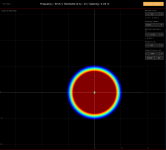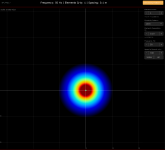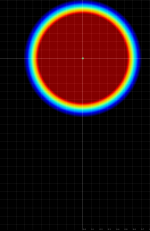No No we are supposed to be focusing on the effects of increase radiation area, and the omnidirectional part of the spectrum.


This is the sim I got from https://www.usound.in.ua/graphs/ by increasing point sources and creating the same sized radiation mass....This is not actually a radiation mass simulation but one for SPL, but the connection to spl and velocity is a close one, so this is the best simulator I have to help express ideas.
This is the sim I got from https://www.usound.in.ua/graphs/ by increasing point sources and creating the same sized radiation mass....This is not actually a radiation mass simulation but one for SPL, but the connection to spl and velocity is a close one, so this is the best simulator I have to help express ideas.
Last edited:
If you are speaking on radiation size, direct energy, vs LF and HF leaving out Directivity, then yes, I agree...With LF we have to consider cycle time...As I said before, I believe that we can sense the direction of pressure in some type of way....So the more Radiation from the source, the more we can sense the pressure coming from that direction....In a room mode, the pressure will seem to come from everywhereWhen talking about the perception of "direct energy" you absolutely have to consider the LF and HF perceptions
The discussion is all over the place, and I've been doing my best to keep these guys from jumping topics....No one expected me to produce the above sim, they thought this thought would just fade away.
Ok I found some more mistakes I made....I said that Radiation mass increased when increasing Radiation Area, which is true but that leaves out volume matching. Radiation Mass size should be identical if volume matched. For example the outer edge is the same spl in the below sim. Increasing Radiation Area increases the area in the sound field that has the same Velocity as the surface of the radiation source...I haven't figured out how to show how this plays out in the real world just yet. The Red in are in these sims may so small in comparison to the baffle that difference between a 4" and 15" are unnoticeable. In regards to LF in a small room, cycle time would null out any advantage of receiving more direct energy according to @gedlee....I went on from there to say many things but the one thing that seems to worthy of holding on to out ability to sense to the direction of the pressure. This ties into another statement I made saying that as you increase Radiation area, in a room, the room becomes less of the final SPL. Hoping Earl would speak on that.


If I can trust certain aspects of this sim then this could be basically a 1m measurement of a sound source small sd and one with high sd.....Obviously velocity is remaining in sync with the diaphragm, for a much larger part of the sound field. I also stated that increasing Sd the point of the critical zone further away from the source. These sims would seem to support that as well. Theres way for connect increasing point sources in this sim to sd other than assuming that everytime I add a point source I am adding X amount SD where X= the sd of the point source....Looking at the sim I cannot shrink the radiation mass below 1m, so 10m = 1m for this matter. A 15" has about 15x more Sd than a 4" so this simulation is in the ball park. The reflective nature of things within the 1m are going vary in velocity much more than whats happening with the smaller woofer. I probably need to research more about Volume Velocity.
If I can trust certain aspects of this sim then this could be basically a 1m measurement of a sound source small sd and one with high sd.....Obviously velocity is remaining in sync with the diaphragm, for a much larger part of the sound field. I also stated that increasing Sd the point of the critical zone further away from the source. These sims would seem to support that as well. Theres way for connect increasing point sources in this sim to sd other than assuming that everytime I add a point source I am adding X amount SD where X= the sd of the point source....Looking at the sim I cannot shrink the radiation mass below 1m, so 10m = 1m for this matter. A 15" has about 15x more Sd than a 4" so this simulation is in the ball park. The reflective nature of things within the 1m are going vary in velocity much more than whats happening with the smaller woofer. I probably need to research more about Volume Velocity.
Last edited:
I particularly liked this one. Makes it sound like we are the ones who need to brush up on our acoustics.Just because no one seems to be well versed in topic of radiation mass size, I should just drop it?
All in jest Camplo, I know that you have come a long ways.
Seems like a reasonably well thought out 2 way, but it's a typical (small) hi-fi concept and so incapable of high SPLs.Apologies if this has been referred to before, but this looks the business; from the highly regarded designer Curt Campbell:
http://speakerdesignworks.com/Invictus_9.html
Geoff
@camplo, I share your inquisitive mind, but it is also recommended to be aware of the tone of voice towards forum members 😉
In order to avoid all kinds of confusing (thought) exercises at a detailed level, it is often useful to zoom out. So to integrate specific objectives/aspects from a broader perspective.
In my view, what you are striving for has everything to do with efficiency (acoustic energy transfer).
The underlying phenomena are many and the complexity of these is high (PhD physics level), so it is commendable to focus on those aspects that we -
as DIY-ers, can deal with.
Last edited:
Reminds of when I tried to explain and talk about the start up transients connection to Group Delay but didnt even know the words start up transient... @gedlee was the only person who understood the material enough to know what I was describing.. Martin King did too, but he's not here. My point is, I don't seem to actually be off in my assumptions when I finally am able to express myself in what we might call, a way that uses words as one is used to hearing them within a profession. Most people didnt even know there could be a connection to amplitude vs time regarding GD 🤷♂️ So no need to be discouraged now.
I am at fault because my explanations are not of the best quality, that doesnt make me wrong, all I am saying is work with me lol
@gedlee Plz answer this; If one increases radiation area, in a room, does this increase the direct sound levels, in proportion to indirect? Have you tested for this?
Edit: I keep forgetting to add that we are talking about in the Omni directional part of the spectrum!
I am at fault because my explanations are not of the best quality, that doesnt make me wrong, all I am saying is work with me lol
@gedlee Plz answer this; If one increases radiation area, in a room, does this increase the direct sound levels, in proportion to indirect? Have you tested for this?
Edit: I keep forgetting to add that we are talking about in the Omni directional part of the spectrum!
Last edited:
Can we see your simulations of some type of display of Radiation Mass showing a small source vs a large source?Even the pictures scream "I am not correct". Comparing apples to oranges will not work.
If it's omni, then the only thing that matters is Volume Velocity (VV) - i.e area * velocity. Smaller area needs more velocity, but if VV is equal then area doesn't matter. I explained this before.@gedlee
Plz answer this; If one increases radiation area, in a room, does this increase the direct sound levels, in proportion to indirect? Have you tested for this?
Edit: I keep forgetting to add that we are talking about in the Omni directional part of the spectrum!
At LFs there is only steady state. Direct sound doesn't matter.
You made my day! The last pictures look more like the corona of a dying sun than related to audio 😱I wonder why anyone is still respoding this thread. I am by no means an expert, but the last few posts by camplo seem way off. Like stimulating a larger source. Even the pictures scream "I am not correct". Comparing apples to oranges will not work.
Do have a sim to show of a 4" vs 15" playing 50hz on infinite baffle, volume matched, at several different volumes? Have you ever seen such a thing?The last pictures look more like the corona of a dying sun than related to audio
Attachments
Both source at 50 Hz will be identical. If they are also both linear, which is difficult for the 4", then they will be identical at all volume levels. For equal output levels, the 4" will have much greater excursion, that's all.
I need simulations...Which means I have to learn the BEM side of Akabak
Here is what I need to do but explained in such a bad way its about useless to a beginner.
https://www.diyaudio.com/community/threads/akabak-3.353871/post-6200129
If I use this method https://www.diyaudio.com/community/threads/akabak-3.353871/post-6194633 to create abox, which there is a tutorial on Youtube, the polars shown do Not show the radiation having any relation to driver size, in the omnidirectional part of the spectrum.....The area closest to the membrane should be high velocity and the radiation should reflect as driver size changes.
Last edited:
I view simulations as the icing on the cake. A way to fine tune a design. As a learning tool, when one does not understand the basics, they are probably not very effective. None of the questions that you have asked so far require simulations to answer. They just require basic knowledge of the principles. This simulation trend of yours seems to be leading you more astray than to any enlightenment.
So the resistance part of the equation.....its linear? A smaller driver will have a larger contrast from high velocity to low velocity from source to listener. Being subject to higher levels of resistance...that doesn't change the shape of the start up transient? In particular in the LF?Smaller area needs more velocity, but if VV is equal then area doesn't matter.
Last edited:
Resistance, as well as all of the pertinent variables are always assumed to be linear. Having said that you need to understand that my usage of the term "linear" may be different from yours. Mine is the proper acoustical one. You seem to be talking about parameter values that are frequency independent. Very different things.
"A smaller driver will have a larger contrast from high velocity to low velocity from source to listener. " Not if it's linear.
Linearity means an independence of the parameters with level. If you think that what your talking about now is confusing, just dabble in nonlinear systems theory for a real eye opening experience. We always assume linearity unless we know that it is not to the extent that systems theory breaks down.
"A smaller driver will have a larger contrast from high velocity to low velocity from source to listener. " Not if it's linear.
Linearity means an independence of the parameters with level. If you think that what your talking about now is confusing, just dabble in nonlinear systems theory for a real eye opening experience. We always assume linearity unless we know that it is not to the extent that systems theory breaks down.
Take for example waveguide theory. I developed this based purely on analytic approaches, no sims were used. This went a long way.I view simulations as the icing on the cake. A way to fine tune a design.
But as Marcel has shown, sims can take things a bit further by tweaking the designs. But this, as I said is "icing on the cake" and not required for a fundamental understanding of the concepts.
Thanks for taking the time, as I am genuinely interested
I still feel like you are holding out on me lol! I say that with good vibes but whats the math on this!?
If I increase direct sound amounts, by increasing Radiation area....Regardless if one can hear it or not, Regardless if Omnidirectional. The direct energy portion of the formula for SPL in a room increases....theres no way it doesn't!
If we never change velocity, and increase volume of pressure waves......SPL goes up. The room aint getting no louder, but direct sound is. The room is a passive device.
How can I measure this myself, I think I asked you before how to separate Direct from Indirect sound in a measurement...I think you said something about software you developed?
See, I would not of thought that. Mainly because I would of guessed the viscosity of air to have harmonics tied into resistanceResistance, as well as all of the pertinent variables are always assumed to be linear.
Yes, but I see it through the effects of Direct energy levels. The FR "system" if you will, is non linear, so the performance asked of the system, is not, as well, in order to appear neutral to the ear.You seem to be talking about parameter values that are frequency independent. Very different things.
I still feel like you are holding out on me lol! I say that with good vibes but whats the math on this!?
If I increase direct sound amounts, by increasing Radiation area....Regardless if one can hear it or not, Regardless if Omnidirectional. The direct energy portion of the formula for SPL in a room increases....theres no way it doesn't!
If we never change velocity, and increase volume of pressure waves......SPL goes up. The room aint getting no louder, but direct sound is. The room is a passive device.
How can I measure this myself, I think I asked you before how to separate Direct from Indirect sound in a measurement...I think you said something about software you developed?
- Home
- Loudspeakers
- Multi-Way
- Is it possible to cover the whole spectrum, high SPL, low distortion with a 2-way?


